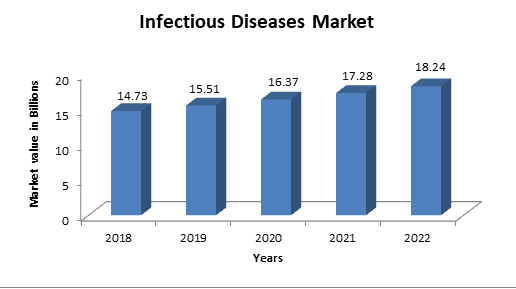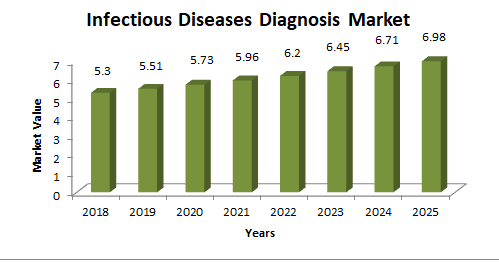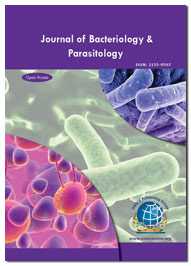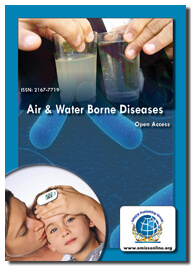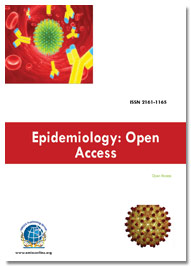Theme: Innovative approaches for Infectious Diseases and its prevention
Tropical Diseases 2020
Join us for 3rd International Conference on Tropical and Infectious Diseases 2020
Update your skills, enhance your knowledge base, and broaden your horizons- all in one place!
Date: November 16-17, 2020
ME Conferences takes the immense Pleasure to invite participants from all over the world to attend the "3rd International Conference on Tropical and Infectious Diseases”during November 16-17, 2020. The conference program focuses on “Innovative approaches for Infectious Diseases, Prevention and Control”. This gathering will strengthen the ideas about infectious Diseases and different aspects related to it. We attempt to provide a perfect stage to Researchers, Scholars, and key Speakers to share data and experiences and empower people with their deep knowledge of Human Infectious Diseases and aspire them to fight against the worldwide risk related to it. The convention meeting consists of discussion and workshops, keynote speeches, absolute talks, poster presentations, e-Poster introductions and a panel session on cutting-edge research traits within the field of Infectious diseases , Prevention, Control and Diagnosis of emerging Diseases.
Why Tropical Diseases 2020?
- Poster - paper presentations and world-class exhibitions
- Opportunities to gain a deeper understanding of the topic
- Intensifying Interactive knowledge
- Meet Academics and Industrial professionals to get inspired
- Great credits for the work in progress
- Valuable talks and symposiums from renowned speakers
- Meaningful sessions and accomplishments
With members from over the world focused on learning about Infectious diseases and its advances; this is your best opportunity to reach the largest assemblage of participants from the Disease biology community. Conduct presentations, distribute information, meet with current and potential scientists, make a splash with new advancements and developments in Infectious Diseases, and receive name recognition at this 2-days event.
Target Audience of Tropical Disease Conference
- Microbiologists
- Pathologists
- Epidemiologists
- Dermatologists
- Allergists
- Immunologists
- Pediatricians
- Physicians
- Pharmacists
- Neurologists
- Veterinary Doctors
- Infection Prevention and Infection Control Specialists
- Academic and Health care Professionals
- Students
- Research Associates
- Health Care Associations & Societies
- Medical & Pharmacy Companies
- Medical Devices and drug Manufacturing Companies
- Laboratory Technicians and Diagnostic Companies
- Business Entrepreneurs and Industrialists
Track 1: Neglected Tropical Diseases
Neglected tropical diseases are a diverse category of communicable diseases in the tropical and subtropical areas, found in 149 countries. In general, the diseases are caused by bacteria, parasites, helminths, fungi, protozoans, viruses, etc. that affect over one billion people and cost billions of dollars per year to developing economies. Which include lymphatic filariasis, onchocerciasis, schistosomiasis, and helminthiasis transmitted from the soil, as well as other neglected diseases that pose a severe public health burden. They affect communities living in poverty, especially without adequate hygiene, sanitation, and in close contact with numerous infectious vectors and diseases that cause livestock, and cause significant health and financial burdens across underdeveloped nations and have a major effect on their socio-economic status. The extent of human suffering caused by untreated tropical diseases remains poorly understood by the public health community, unlike other public health threats such as malaria, tuberculosis, dengue fever, leprosy, leishmaniasis, schistosomiasis, hookworm infection and HIV.
Track 2: Allergy and Clinical Immunology
Allergic disease happens when an individual's immune system responds to biologically occurring chemicals that are harmless to most people. Known as allergens, such compounds are present in dust mites, plants, livestock, ticks, pollen, bacteria, moulds and certain medicines.
Clinical immunology associated with disease studies triggered by immune system disorders, i.e. excessive development in all of the system's cell types, hypersensitivities such as asthma, immune system malfunction and other allergies. It also includes other systems ' disorders, where immune response plays a crucial role in the clinical aspects and pathology.
Track 3: Pediatric Infectious Diseases
Pediatric infectious diseases / infectious diseases of the childhood are infectious diseases induced by growing age groups of children. Infection from mother to foetus, there is increasing danger in babies and children just born. Death levels are on the rise because of infections. Despite being more endangered the epidemiological characteristics of congenital and neonatal diseases due to bacterial, viral, vector-borne infections.
Track 4: Rare diseases and Orphan Drugs
A Rare disease is any illness affecting a significantly smaller percentage of the population. Most genetic disorders are inherited, and thus persist throughout the individual's entire life and are caused directly by gene or chromosome changes. For certain cases genetic shifts are transmitted from generation to generation. In other cases, they occur at random in a person who is the first to be diagnosed in a family. Lots of unusual illnesses occur early in life. The exact cause for many rare diseases remains unknown. But Environmental factors, viral infections, genetic mutations, diet, smoking, or exposure to chemicals, also can play a role in rare diseases. Many rare diseases, including infections, a few rare cancers, and a few immune system infections, are not inherited. While researchers are learning more each year, the correct cause of many rare diseases is still unknown. Researches are still going on for this uncommon illness.
Track 5: HIV/AIDS and Sexually Transmitted Infections
Human immune deficiency virus is detrimental to the immune system. Untreated HIV contaminates the CD4 cells and causes damage. HIV then kills more and more CD4 cells, because of which the body is expected to get all kinds of illnesses and malignant growths. In general, HIV is transmitted by organic liquids containing blood, breast milk, semen, vaginal and rectal liquids. In general, the infection does not spread by air, water or through simple touch. HIV is a lifelong illness and there is no cure for this extreme disease right now. Without medication, an HIV-positive man would eventually develop a serious condition called AIDS.
Sexually transmitted diseases (STDs) are also known as Sexually Transmitted Infections (STIs) or Venereal Diseases (VDs) which are those infections that have passed by sexual contact from one person to another. Bacteria, yeast, bacteria, and viruses are typically responsible for STDs. There are over 20 forms of STDs that affect men and women alike. It affects Women most of all. Antibiotics can treat developing STDs. There is certainly no remedy for virus-initiated STDs, but medications will also help with the symptoms and keep the infection in check.
Track 6: Respiratory and Pulmonary Infectious Diseases
Lung or airway infection is referred to as Respiratory or Pulmonary infections. Chronic Bronchitis, Asthma, COPD, Influeza, Tuberculosis, Lung Cancer and Pneumonia are the major forms of respiratory infections. Hence, nasopharyngeal infections result in a nasal discharge, bronchitis leads to cough and sputum development, and pneumonia leads to cough and sputum, it also increases respiratory rate and changes in chest radiography. Many viruses contribute to increased bronchitis, while the majority of bacteria contribute to increased pneumonia. Infections usually spread from an infected person to a healthy person when an infected person coughs or sneezes.
Track 7: Gastro Intestinal Infections
The Advancement of gastrointestinal disease diagnosis and treatment has been excellent at the moment. Gastrointestinal infections are infectious, bacterial, or parasitic infections that can cause gastroenteritis, a gastrointestinal tract inflammation that affects both the stomach and small intestine. Symptoms include diarrhea, stomach pain and vomiting. Many new diagnostic approaches and innovative therapeutic mechanisms for gastresophageal reflux disease (GERD), pancreatic-biliary and post-surgical complications, Barrett's throat, neuroendocrine tumors and gastrointestinal stromal tumors are undergoing consideration.
Track 8: Vector-Borne and Zoonotic Infectious Diseases
Vector-borne diseases and zoonotic diseases (VBZD) are infectious diseases which spread via vectors or host animals. Vector-borne diseases such as Dengue, malaria, Lyme disease, in which an organism such as ticks, mosquitoes, or mites transmits a pathogen from one host to another that can be transferred from human to human, or from animal to person. Commonly with increased pathogen virulence at the vector.
Zoonotic diseases such as avian flu, animal flu, anthrax, bird flu can spread from animals to humans either through animal contact or through vectors that transmit animal to human zoonotic pathogens. Although many vectors with diseases such as malaria, yellow fever, dengue, and murine typhus are seldom seen, other disease-borne vectors are climate prone, and climate change-related environmental changes are likely to affect the occurrences and spread of these diseases.
Track 9: Infectious Diseases and Cancer
Cancer is a complex group of multi- illnesses. Learning more about the known causes of cancer remains therefore an important issue. In addition, infection, and its connection with cancers, is controversial among all these factors. Infectious agents, such as hepatitis B (HBV), C viruses (HCV), type 1 human immunodeficiency virus (HIV-1), human papillomavirus (HPV), Epstein- virus (EBV), Streptococcus bovis (S. bovis), and Helicobacter pylori (H. pylori), contribute to the pathogenesis of various cancers.
Such cancers include hepatocellular carcinoma, nasopharyngeal carcinoma, Kaposi sarcoma, adenocarcinoma, lymphoma, Burkitt lymphoma, cervical cancer, non- lymphoma. Screenings of infectious diseases in cancer patients that open the research areas for identifying strategies to improve cancer control.
Track 10: Dental and Oral Infectious Disease
Dental and oral infections are among human diseases that are most common. Two frequently occurring oral diseases are periodontal illness and caries disease. Dental caries is one of adolescence's most well-known chronic disease that is widely ignored by youths. Periodontal disease is adult infectious disease which is generally known. Chronic parodontitis affects at least 1/3 of the population, which is a bacterially instigated degradation of the attachment of the tooth to the bone. The Non-disposable items such as dental instruments between patients should be washed and disinfected. On another user, the disposable dental instruments and needles will never be used again. Contamination control and precautionary measures jointly required for the use of protective garments, such as gloves, coverings, uniforms and eyewear by all dental personnel involved with quiet treatment.
Track 11: Tropical Medicine and Health
With the high rate of emerging Infectious Diseases across the Tropical region there is more and more requirement of Medicine and new preventive measure especially in the Under developed countries. Tropical medicine doctors treat patients with a wide range of tropical infections including malaria and hepatitis.
Track 12: Advancements in Vaccines and Therapeutics
Vaccines are the products which can produce immunity from a disease and can be administered to the organism through needle injections, by mouth or by aerosol. Vaccination is the injection of either killed or weakened organism that produces immunity in the body against that organism. The most common and serious vaccine-preventable diseases tracked by the World Health Organization are: Diphtheria, Haemophilus influenzae serotype b infection, Hepatitis B virus infection, Measles, Meningitis, Mumps, Pertussis, Poliomyelitis, Rubella, Tetanus, Tuberculosis, and Yellow fever. Various therapies like Gene therapies are considered as the potential treatment for various infectious diseases as well as Hereditary Genetic Diseases. Gene therapy may be used to mediate the spread of the infectious agent at the extracellular level.
Track 13: Infection Control And Public Health Awareness
Infectious diseases prevention and control is helpful to prevent the transmission of infectious/communicable diseases. Some prevention must be followed like sanitation, hand washing, food & water safety and vaccination for infection prevention and control to decrease the spread of microorganisms and diseases. Anti-infective agents include antibiotics, antibacterials, antifungals, antivirals and antiprotozoals which control the growth of disease causing organisms. Sterilization is another process of killing microorganisms by Physical, Chemical and other physio-chemical methods. Disinfection is also a process of killing harmful microorganisms. Some infectious diseases can be prevented by avoiding direct contact with the infected person. Infections can also be controlled and prevented by creating public awareness on infectious diseases and their outbreaks. Public Health awareness refers to the important role that community knowledge and enthusiasm has in building manageable societies. It includes delivering knowledge to remote communities requires strategies for effective communication regarding infections treatment and control and maintenance of good hygienic conditions by creating healthy environment and infection free world.
Track 14: Molecular Diagnosis and Treatment of Infectious Diseases
Medical diagnosis is the process of determining the type of disease or condition that explains a person's symptoms and signs. Laboratory tests may identify the organisms directly by visualizing the organism on a culture by a microscope or indirectly identifying antibodies to the organism. General types of tests include microscopy, culture and immunologic tests i:e; agglutination tests such as western blot, latex agglutination, enzyme immunoassays, complement fixation tests, precipitation tests and nucleic acid/ no- nucleic acid-based identification methods. Sub types of diagnosis may include clinical, laboratory, radiology, principal and admitting diagnosis. Advanced methods include biomarkers/ Elisa test/ chest x ray/ skin biopsy/ Tympanometry and tympanocentesis have been implemented to diagnose the infection rapidly.
Treatment of infections involves patient care and moral support including corresponding therapies. Bacterial infections can be easily treated by administering antibiotics to the patients. Yeast infections can be primarily treated by sterilization and the parasitic infections can be treated by antiparasitic drugs. Diseases such as cancer can be treated by chemotherapy techniques. Advanced techniques have proved that there is no disease that cannot be treated.
Scope and Importance
Tropical and Infectious diseases are the diseases that caused by various microorganisms are commonly known as pathogens. The diseases are less prevalent in temperate climates, due to in part to the occurrence of a cold season, which controls the insect population by forcing hibernation. These diseases generally afflict the world’s poor and historically have not received as much attention as other diseases. However, many were also present in northern Europe and northern America in the 17th and 18th centuries before modern understanding of disease causation.
Infectious diseases thrives in the hot and humid climatic conditions which is suitable for the growth of the microorganisms like Bacteria, Parasites, Fungi, Protozoa, Helminthes, Virus etc. The population of vectors like Mosquitoes and insects also thrive which transmit diseased pathogens. A large number of lives can be saved if they are diagnosed early and medical interventions are taken accordingly. The major factorial entities supporting the growth in demand for infectious disease diagnostic market are rise in population of countries, increasing prevalence rate of tropical Diseases and infectious diseases, access to healthcare services and government intervention. Due to high population rate, poverty, lack of sanitation and portable water the infectious disease has a high prevalence and incident rate in various countries.
Infectious Diseases Market:
The global infectious disease valued at $14.73 Billion in 2018 and it is stipulated to reach $19.35 billion by 2022 growing at CAGR of 5.6%. The market growth of infectious diseases id sue to increase in the awareness of infections and their environmental factors, global prevalence of diseases and increasing preference of Point-of-care testing and availability of funds for research and market for novel technologies.
Global Burden of Tropical and infectious Diseases:
World Health Organization provides a list of 17 diseases: bacterial diseases (yaws, trachoma leprosy. Buruli ulcer), helminth diseases (schistosomiasis, cystercercosis or taeniasis. Onchocerciasis, Lymphatic Filariasis) protozoan parasitic diseases (leishmaniasis. Chagas disease, and human African trypanosomiasis) viral diseases (dengue, chikungunyu and rabies) and diseases caused by soil -transmitted helminths echinococcosis and Dracunculiasis and food-borne diseases. Cases have been made for the addition of others (for example mycetoma and to remove some (for example dengue) that are subject to substantial impact and research investment in middle-income countries. Infectious disease affects more than one billion people each year. Country invests about billions of economic dollars every year.
No. of people affected each year
Infectious Disease Therapeutics Market:
The global infectious disease therapeutics market size was valued at $46.88 billion in 2018 and is estimated to reach at $64.5 in 2023 ,at a CAGR of 6.6%. Rising prevalence of infectious ailments and increasing expenditure to boost the penetration rate of treatments of these diseases, rising initiatives for creating awareness about treatments & diagnosis of disease conditions, and increasing clinical trial for development of new drugs are likely to be the factors responsible for growth of this market.
Infectious Diseases Diagnosis market:
Rising of the infectious diseases concern regarding Tropical Diseases and its global impact on population as well as governments has powered demand for development of early disease detection methods like POC diagnosis. This growth in concern is evident by launch of a substantial number of programs aiming to combat Infectious Diseases.
The global infectious diseases market size is estimated to reach $7.6 billion by 2025 at a CAGR of 4.1 %. The combined effect of high impact factors such as soaring disease burden. growing demand for early disease identification and complementary advancements in technology expected to drive growth in demand.
Infectious Disease Funding Market:
Due to the increasing rate of the tropical and infectious diseases in worldwide it needs to use more tools for the diagnosis and prevention for the diseases. Public and phlantriphic funding is required to develop new technologies to control the diseases." Global Funding of Innovation for infectious Disease" invests mill ions of rupees every year.
MAJOR INFECTION PREVENTION RESEARCH ASSOCIATIONS
- Asia Pacific Society of Infection Control
- British HIV Association
- British Infection Association
- Centers for Disease Control
- European Centre for Disease Prevention and Control
- European Society for Clinical Microbiology and Infectious Diseases
- Health Protection Scotland
- Healthcare Infection Society
- Infect ion Prevention Society
- Infection Control Association
- Infection Prevent on & Control- American Nurses Association
- Infectious Disease Society of America
- International Federation of Infection Control
- Royal Society for Public Health
- Society for General Microbiology
- The Infection Control Nurses Association
- The Royal Society of Tropical Medicine and Hygiene
- The Society of Health care Epidemiology of America
- UK Clinical Virology Network
- World Health Organization
MAJOR COMPANIES ASSOCIATED WITH INFECTION PREVENTION
- Abbott Laboratories
- Aegerion Pharmaceuticals
- Amicus Therapeutics
- Araim Pharmaceuticals
- AstraZeneca
- Baxter International Deerfield
- Bayer HealthCare
- Beacon Pharmaceuticals
- Bioxyne Limited
- Chiesi Pharmaceutical
- Daiichi Sankyo
- Dohmen Life Science
- Forest Laboratories
- Generics (UK) ltd
- Gilead sciences
- GlaxoSmithKline
- Hormosan Pharma
- Kyowa Hakko Kirin Co. Ltd
- Lallemand Pharma
- Napp Pharmaceuticals ltd
- Novartis
- Onyx Pharmaceuticals
- Otsuka Holdings Co., ltd
- Panmira Pharmaceuticals, LLC
- Pfizer
- PharmaMar
- Prosensa
- Boehringer lngelheim
- Ranbaxy laboratories Limited
- Raptor Therapeutics
- Roche
- Sanofi
Conference Highlights
- Neglected Tropical Diseases
- Tropical Medicine and Health
- Allergy and Clinical Immunology
- Pediatric Infectious Diseases
- Rare diseases and Orphan drugs
- HIV/AIDS and Sexually Transmitted Infections
- Respiratory and Pulmonary Infectious Diseases
- Gastro Intestinal Infections
- Vector-Borne and Zoonotic Infectious Diseases
- Infectious Diseases and Cancer
- Dental and Oral Infectious Disease
- Advancements in Vaccines and Therapeutics
- Infection Control And Public Health Awareness
- Molecular Diagnosis and Treatment of Infectious Diseases
To share your views and research, please click here to register for the Conference.
To Collaborate Scientific Professionals around the World
| Conference Date | November 16-17, 2020 | ||
| Sponsors & Exhibitors |
|
||
| Speaker Opportunity Closed | |||
| Poster Opportunity Closed | Click Here to View | ||
Useful Links
Special Issues
All accepted abstracts will be published in respective Our International Journals.
- Journal of Infectious Diseases & Therapy
- Journal of Bacteriology & Parasitology
- Air & Water Borne Diseases
Abstracts will be provided with Digital Object Identifier by



